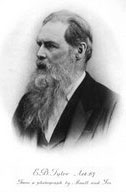"When
explorers examined the remains of an advanced Mexican culture, they
concluded that a superior race must have come from elsewhere to build
the palaces and pyramids: the theory of diffusionism was born. This
program charts the 150-year search for civilization's origins, which
most 19th and early 20th century archaeologists believed to be a
single source. Though questioned in the 1950s by Henri Frankfort,
the diffusion theory persisted, as this program shows, and received
interpretations ranging from Thor Heyerdahl's idea that the Mexican
pyramids were built by the Egyptians to notions that they were made
by aliens—all under the premise that the ancient Mexicans could not
have done it themselves." -- Films
for the Humanities and Sciences
"This program charts the 150-year search for civilization's origins, which most 19th and early 20th century archaeologists believed to be a single source. Though questioned in the 1950s by Henri Frankfort, the diffusion theory persisted . . . and received interpretations ranging from Thor Heyerdahl's idea that the Mexican pyramids were built by the Egyptions to notions that they were made by aliens" -- Container label
Terms / Concepts / Features:
- basic mechanisms of change
- invention
- migration
- diffusion
- 1521
- death and human sacrifice
- tzompantli
- pre-dynastic pottery
- centers of agriculture
- maize-based cultures of the New World
- wheat-based cultures of the Near East
- rice-based cultures of the Far East
- millet-based cultures of Africa
- manioc-based cultures of South America
Notes:
-
unlike the early Egyptians, the Mayan people had not disappeared when their civilization(s) fell
Cultures:
Sites:
- Palenque (Maya)
- Monte Albán (Zapotec, Mixtec, Oaxaca)
- ca. 1300 B.C. -- first village houses in the valley of Oaxaca
- San José Mogote
- interiors divided into two separate areas
- Mexico City / Tenochtitlán (Aztec)
- Zocalo -- center city plaza
- Egypt
Individuals:
- Frederick Catherwood (1840s)
- Cortez
- John L. Stephens (1840s)
- Incidents of Travel in
Incidents of travel in Central America, Chiapas, & Yucataán
- Sir Edward Bernett Tylor

- Theory: "Unity of the Human Race
"
-
Theory: "Diffusionism"
- Publications
- Anahuac; or, Mexico and the Mexicans, Ancient and Modern (1861)
- Henri Frankfort
- William Flinders Petrie
- James Henry Breasted
- coined the term "fertile crescent"
- analyzed the mentality of ancient Egyptians and ancient Sumarians
- Alberto Ruz Lhuillier
- Thor Heyerdahl
- Eric
Von Daniken
|
